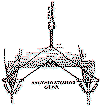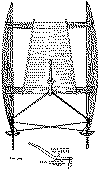By Dan Beard

Figs. 194 & 195
Stick for Rudder-Post of Catamaran
Evidently it would be a most difficult undertaking to steer the catamaran with independent rudders, and we must devise a method by which one tiller will control both.

Figs. 196-198
Rudder-Post of Catamaran
Fig. 201 shows how it may be done with a system of Pulleys or blocks and till-lines, or you may make a short oaken stick of the form shown in Fig. 194, A. Bore a hole through the center, as is shown in Fig. 195, B. Trim off the top to fit the tiller-handle (Fig. 196, C). Saw into all the four corners of the square stick to form a shoulder to rest on the bench. Fig. 197 shows the shoulder at S. Plane off the square corners of the wood below the saw cut.

Fig. 199
Rudder Bench of Catamaran
After this it is quite a simple matter to round it off below the shoulder (Fig. 197, E).

Fig. 200
Half Hull of Catamaran
After slipping the rudder-post through the two holes bored for the purpose in the rudder bench, drive through the post a good, strong oaken or hickory peg (Fig. 198, F), and bind the cross-pieces tightly with tarred twine. The end of the cross-sticks should be firmly lashed with tarred or painted twine. A large screw-eye may be now put in each end of the cross-stick or near the ends, allowing the screw ends of the eye to protrude far enough to screw on a nut.

Fig. 201
Tackle for Steering a Catamaran
Now we must have two long, strong hoop poles to connect with the rudders by means of bolts and rings, as shown in Fig. 191. All that is now necessary is to fit your tiller-handle over the top of the rudder-post, and the steering apparatus is finished. Fig. 201 shows another plan for steering with a helm like Figs. 202 and 203.

Fig. 202
The Half Hull with Double Block Steering Gear.
Fig. 203
The Side View of Helm
The mast is stepped in a bench at the bow similar to the rudder bench. Each consists of board benches bolted to heavy plank supports and bolted to the deck. The material used should be as light as possible, consistent with strength. The dry deck can be made of neatly planed boards, and the whole craft may be as neat and well done as the skill of the maker will admit. Hulls with a swell on each side jam the water between them and retard the boat; so if you build the catamaran with half hulls you will do away with this objection. Fig. 200 shows diagram of hull; Fig. 202, plan of craft; Fig. 203, the helm.

Fig. 204
Detail of Rudder, Showing Braces and Rings.
AA' BB' for the Rudder-pin, C, to fit in.
D is the Ring for Attaching Steering Gear.
A Tom Thumb Catamaran
could be built just large enough to hold one boy. The dry deck may be made with bamboo poles, in the form of a seat for the sailor, and if a foot-rest is added below, he may sit perched in his dry seat like a horse-jockey in a sulky, where he can manage his little craft in weather that no other small boat, could stand. Some people say that under a heavy sail and a hard blow this style of boat will rear up at the stern and go end over end. If this is true, it is because the craft is too short and dumpy, or has too large a spread of canvas. Even full- rigged ships have been known to run their bows under.
There was a good-sized catamaran wrecked in Flushing Bay the same day that the writer upset in his canoe, but from the looks of the wreck, with its sails torn to ribbons, it seemed probable that the sails had been carried away, and the craft had then drifted ashore. The wreck showed no signs of having turned somersaults.
Two old single shells would make a beautiful Tom Thumb catamaran, and they would be far more likely to sail Up in the air than to stand on end, but all these gymnastics on the part of the boat can be avoided by not venturing out during a gale or by shortening sail when the wind is strong. Never be misled into thinking it seamanlike to carry full sail when other boats are reefed. Too much sail retards the boat as much as too little. In all yacht races the skippers never hesitate to take in sail when it is necessary any more than they do to shake out a reef when more sail is thought to be beneficial.
Danger of False Pride
Learn to manage a small sail first and then a larger one. Do not be ashamed of blunders. Why should you? Is a baby ashamed to creep before it learns to walk? On the contrary, the baby is very proud of its newly acquired powers of locomotion. Nobody is a born sailor. The best seaman was once a land-lubber.